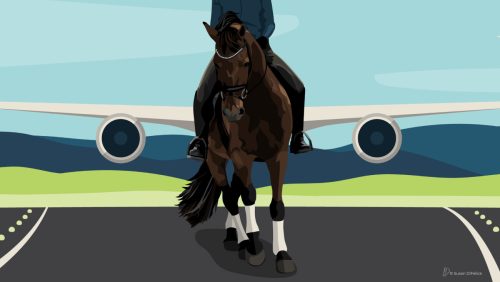Imagine you have a large amount of bread dough. You divide it evenly and fill one long loaf pan with half and put the other half in a shorter pan with taller sides. How would the two loaves look once they’re baked? The one in the long pan would look closer to a baguette, and the one in the short pan would look more like a lovely, round sourdough or brioche. Mmmmm … both delicious.
This is somewhat similar to what we do with the horses as we collect them. We narrow their base over time (make the pan shorter) as we bring the hind legs more under and teach the thoracic sling to engage. The bridge of the back lifts, the front end lifts, the whole base of the horse becomes shorter and the topline looks rounder and taller, like a yummy brioche roll.

Collection is a hard thing to explain to people. It’s sometimes easier to say what it’s not: It is not pulling the horse together from the front; it is not just slower and smaller strides; it is not jacking the neck up higher and shorter.
One way of explaining what it is is to think of “collecting the energy” in a smaller space, and therefore the energy “rises” higher, similar to bread baking in a loaf pan. The pan provides the parameters. It could be long and flat, as with a young horse who is not yet well-balanced, or it could be shorter with higher sides, like on a highly trained horse.
So what are the ingredients for this recipe? I’d argue that the training pyramid is our ingredient list: rhythm, suppleness and relaxation, connection, impulsion and straightness. These are the things that will result in collection, which sits at the top of the training pyramid. But it’s not enough to just have ingredients, you also must have a recipe for what to do with those ingredients, and that’s what our daily training is.
ADVERTISEMENT
Each recipe is slightly different, just as each horse is slightly different. Certain breeds offer slightly different “ingredients,” and different riders will have somewhat different techniques.
The exercises we do with our horses in dressage, gradually “bake” the horse into this ultimate goal of collection and self-carriage. And just like a recipe has steps which must be followed in the correct order, our training has exercises that take the ingredients and gradually make them into something. If you try to skip a bunch of steps, you’ll have one messed up loaf of bread at the end! Or if you think you can just leave out a few ingredients, you’ll be unsatisfied with the end result.
Eliza Sydnor Romm is an FEI rider and trainer from Chapel Hill, North Carolina. She is a USDF Certified Instructor and sought-after trainer and clinician. She teaches horses and riders of all levels, from starting under saddle to Grand Prix.
Susan DiFelice is a lifelong rider and award-winning equestrian illustrator. She founded Allpony, an educational platform offering courses, games, and printables on horsemanship, which was recently acquired by U.S. Pony Clubs. She is passionate about fostering creative partnerships and producing illustrations for professionals and brands seeking to make an impact in the equestrian world.














